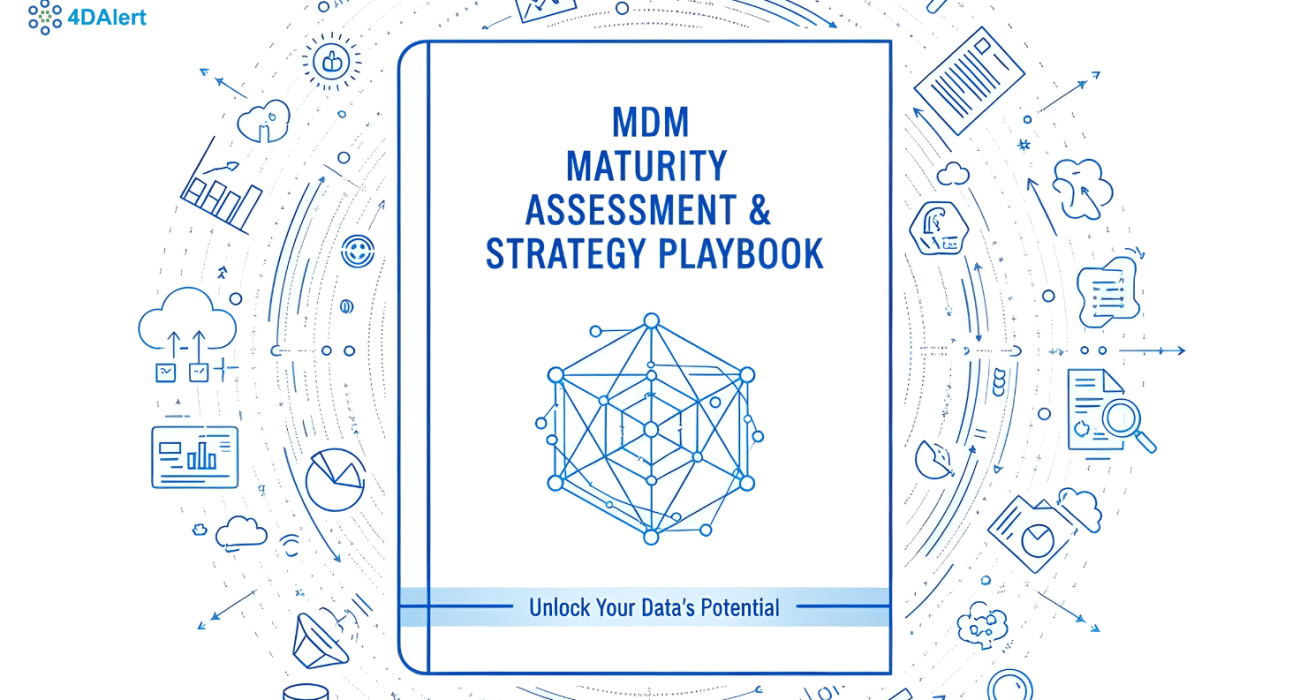Table of Contents
Author

Sukant Palo
Co-founder and Head of AI
Our motivation for the Playbook
We want our customers to drive successful transformation and deliver value from our AI-powered MDM solution, 4DAlert. However, many enterprises approach Master Data Management (MDM) as a technology project, focusing narrowly on tools and platforms. In reality, MDM is a business and IT transformation initiative that requires alignment across strategy, governance, processes, and culture. A common cause of failure is the lack of a collaborative business-IT strategy and roadmap, resulting in fragmented ownership, unclear accountability, and limited realization of business value.
👉 MDM is not about technology alone — it is business & IT Transformation. Success requires shared accountability between Business and IT, with governance, culture, and process embedded alongside platform investments.
The Fundamental Question — Why MDM?
Master Data Management (MDM) is the foundation of trusted, consistent, and governed data that fuels enterprise decision-making and digital transformation. Through our extensive experience in the enterprise and working with our clients, we identify three key value drivers for the MDM Program.
⦿ Business value at stake: Poor master data management leads to duplicated records, inconsistent product/customer data, compliance risk, and missed revenue opportunities.
⦿ Strategic enabler: High-quality, governed data powers AI, analytics, regulatory reporting, digital experiences, and operational efficiency.
⦿ Enterprise risk: Without an enterprise-wide approach, MDM efforts remain siloed, underfunded, and unable to scale — wasting investment and eroding trust in data.
Purpose of the Assessment and Playbook
We want to provide executives and leaders with a structured framework to:

⦿ Objectively measure the current state maturity of Organizational and MDM Capability across People, Process, and Technology based on industry best practices and our decades of enterprise experience.
⦿ Highlight misalignments and maturity gaps that may hinder transformation.
⦿ Build a shared baseline for a unified, business-driven MDM roadmap that IT can enable and scale.
Who is this playbook for?
This playbook is designed for Business and IT leaders who are jointly accountable for unlocking business value from organizational core master data assets. It is particularly relevant for:
⦿ Executive Sponsors (CIO and Business Unit Leaders): To align MDM with enterprise strategy and digital transformation priorities.
⦿ Business & IT Leaders: To build a case for MDM Transformation, business alignment and roadmap development, MDM Project Funding & Technology evaluation, Operating Model & Roles to support MDM Programs.
⦿ IT Leaders & Architects: To design and scale the technology capabilities that enable business-driven MDM outcomes.
⦿ Data Governance and stewardship Teams: To operationalize data quality, governance, and stewardship practices across domains and ensure consistent adoption. Establish accountability for data domains (e.g., Customer, Product, Supplier) and embed data governance into day-to-day business processes.
How to Use This Playbook?
Step 1 — Self-Assessment Questionnaire: Leaders across Business and IT answer structured questions in 4 critical MDM domains and capabilities:
Scoring : For each question, provide your self-assessment score and capture evidence/notes.
Self Assessment score
0 : Absent or Ad-hoc
1 : Developing or Reactive
2 : Managed or Proactive
3 : Optimized
Optionally: Apply weights by assigning % to each of the four domains, the sum of all weights should be 100% (e.g., Strategy and vision 25%, Data Governance Model 20%, Technology & Architecture 40%, Operating Model and Culture 15%), depending on organizational priorities.
Step 2 Dashboard Outputs: Results are automatically summarized in a dashboard that highlights strengths, gaps, and overall enterprise readiness.
Maturity Scorecard to show the average domain score and overall maturity score.
Radar chart (spider chart) to quickly visualize maturity distribution across domains.
Guidance on Interpreting Results
Individual question self-assessment scores are averaged to provide both a domain-level and overall maturity score.
Average Score Maturity Levels:
⦿ Absent or Ad-hoc (0 -1): Ad-hoc efforts, high fragmentation, limited governance.
⦿ Developing or Reactive (1–2): Some pilot implementations, emerging governance, and inconsistent adoption. Lack of MDM Technology and capability maturity.
⦿ Managed or Proactive (2–3): Governance and processes are established. Modern MDM Solution has been implemented for 1–2 domains, and adoption is measurable.
⦿ Optimized (3): Enterprise-wide adoption, MDM integrated into business processes across the data domain, strong stewardship. Continuous improvement, a data-driven culture, and MDM are strategic enablers.
Business/IT Alignment: Results should be interpreted not just as technical gaps, but as indicators of Organizational business & IT capability maturity.
Benchmarking: Compare scores across domains — e.g., strong technology but weak governance indicates risks in realizing business value.
Leadership next steps
Executive Alignment: Use the results to drive a joint conversation between Business and IT on shared ownership of master data.
Prioritization of Initiatives: Focus on low-scoring, high-impact areas (e.g., governance, stewardship, or data quality monitoring). Top 5 priority actions — e.g., establish data owners, deploy profiling & monitoring, implement API for Customer 360, define survivorship rules, create executive KPI dashboard.
Now/Next/Later Roadmap Development: Translate assessment findings into a 90-day Now plan, a 6-month Next plan, and a 12-month Later plan with defined outcomes.
Quick Wins: Launch visible initiatives (e.g., data quality dashboard, assigning business stewards) to demonstrate value.
Long-Term Vision: Position MDM as a data product platform that enables AI, analytics, and digital transformation.

